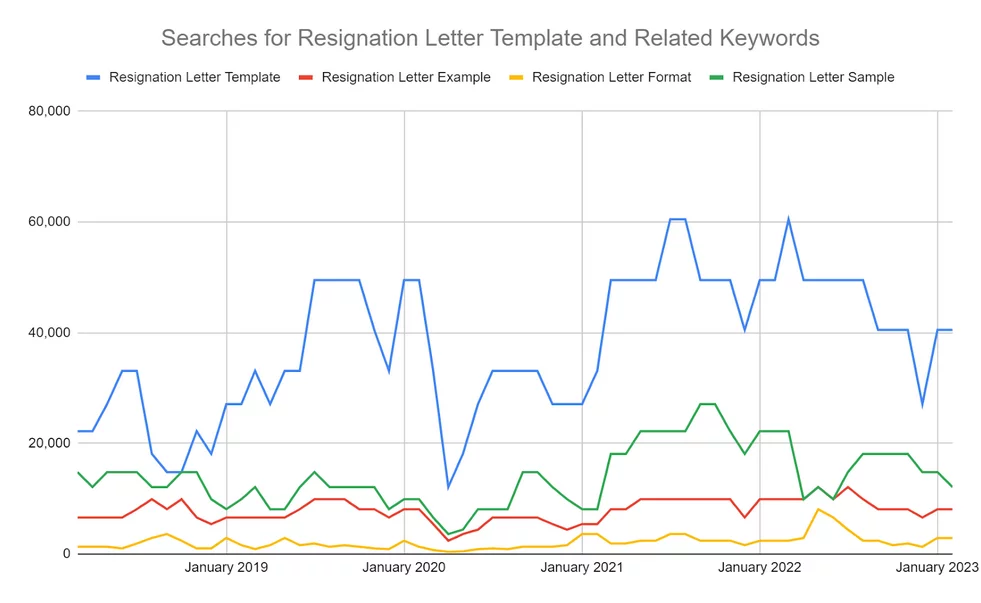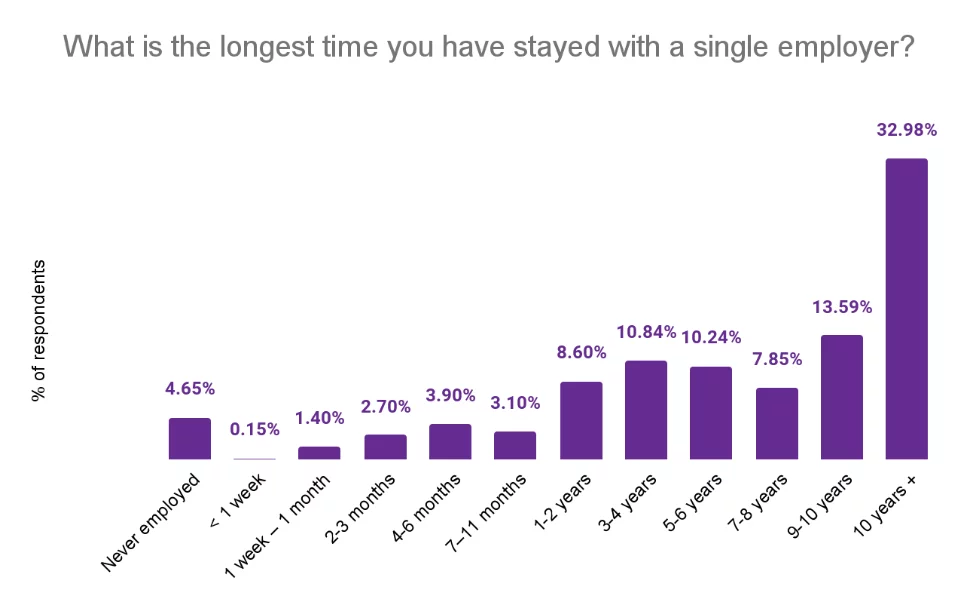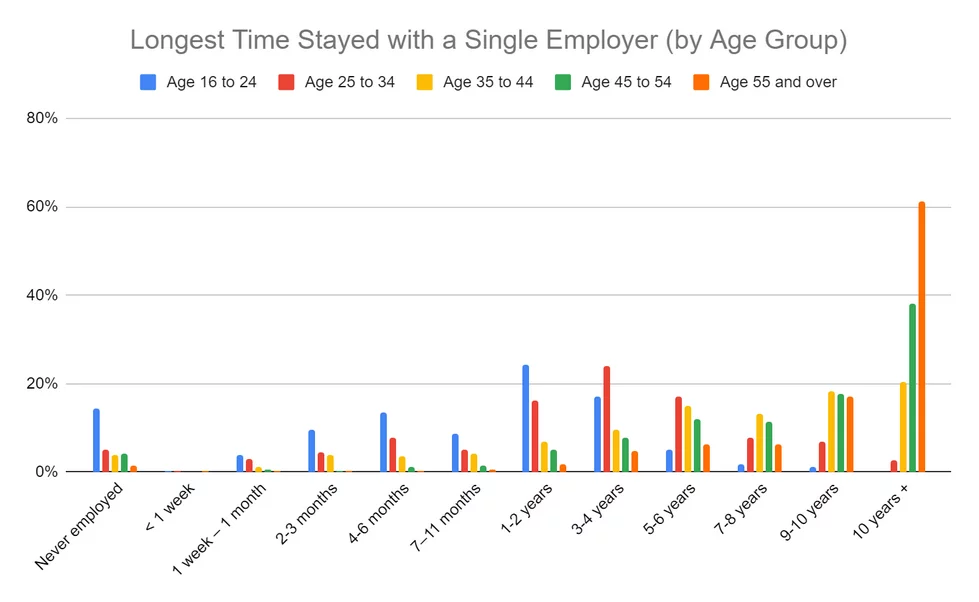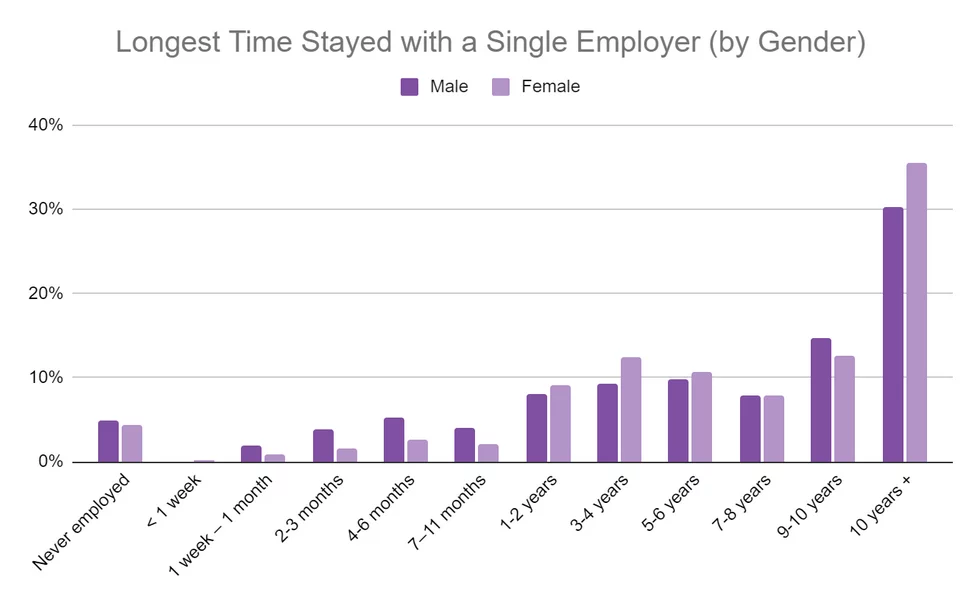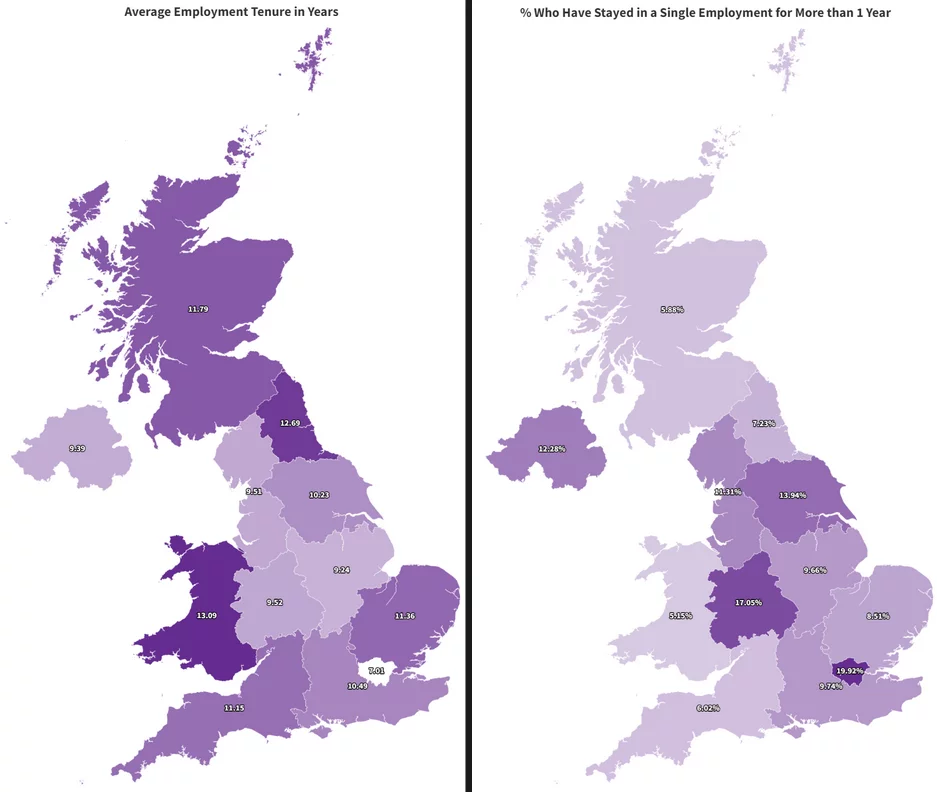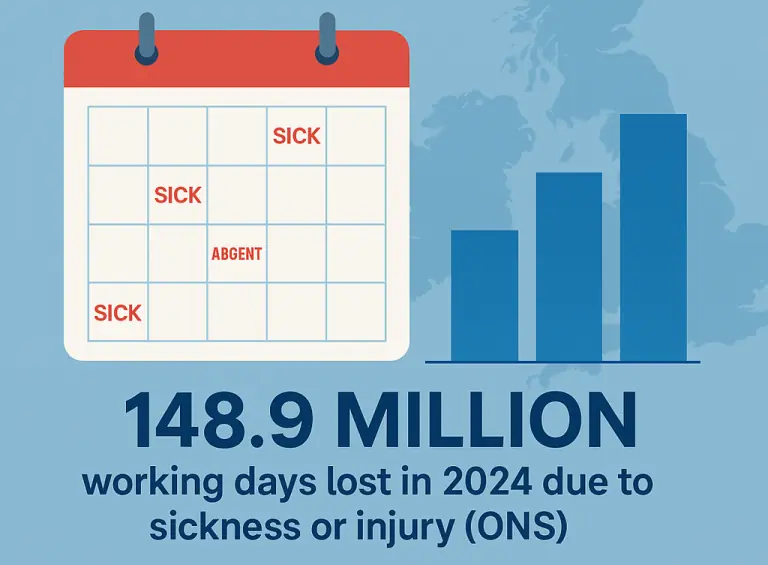
Employee Retention Statistics [Updated For 2025!]
Contents
- 1 Why Do People Quit Their Jobs?
- 2 The Great Resignation (Letter Template)
- 3 How Long do People Stay in a Job on Average?
- 4 Age and Average Employment Tenure
- 5 Maximum Employment Tenure by Gender
- 6 Regional Variations
- 7 Average Employee Turnover
- 8 Cost of Replacing Staff
- 9 In Conclusion
- 10 Methodology
- 11 Appendix: Tables
Keeping staff is absolutely vital to the success of your business.
Getting the right people in place and keeping them is something that business owners have front of mind.
But how hard is it? What causes people to leave their jobs?
We take a look in our round up of employee retention statistics.
Key Takeaways: Employee Retention Statistics
- The UK average employee turnover rate is 15% per year.
- There were over 20,000 searches made every month for “resignation letter template” in 2024.
- 15% of people that resign from a job state feeling “unmotivated” as the reason.
Why Do People Quit Their Jobs?
A 2022 study by Edenred uncovered the most common reasons for quitting a job. They are:
- Feeling unmotivated (15% of the 2,000 people surveyed cited this as a reason for quitting a job)
- Being overworked (14%)
- Management don’t care about wellbeing (14%)
- Poor atmosphere (14%)
- Less pay than I wanted (13%)
- Rude boss (11%)
- No room to progress (11%)
So a lack of motivation, being overworked, underpaid and feeling like management don’t care are the leading causes of resignations.

The Great Resignation (Letter Template)
One means of getting into the psyche of the Great British public is by having a little nosey at their Google history.
While there probably aren’t too many people volunteering up that information, we are able to get some information from Google.
Using Kwfinder.com we took a look for the estimated number of searches each month for queries relating to resignation letters and resignation letter templates to see whether the demand for help to resign is changing.
We looked at UK estimated monthly volumes over time for the following keywords:
The trends we can see in these numbers show:
- We see peaks in searches around July most years
- The height of the covid pandemic saw demand for resignation letter templates and help fall drastically
- Searches for “resignation letter template” increased from 22,200 in March 2019 to a huge 40,500 in February 2023
How Long do People Stay in a Job on Average?
In order to find out how long the average employee tenure has lasted in the UK, we surveyed 2,001 people in April 2023 to ask the question:
“What is the longest time you have stayed with a single employer?”
We found the following:
Diving into the data, with the help of the market research provider, Censuswide, we found the average (mean) was 10.1 years.
In other words, for people in the UK, the average longest employment tenure is over a decade.
We also found:
- For more than 1 in 10 people in the UK, their longest employment tenure so far has been under a year
- Almost 1 in 5 people in the UK haven’t stayed with a single employer for more than 2 years
- On the other hand, for almost a third of the adult population, their longest tenure with a single employer has been over a decade
Part of the reason people leave their jobs is they don’t feel well taken care of.
Check out our guide to taking care of your team here to help prevent it!
Age and Average Employment Tenure
Now, of course, age affects these things.
Those who are older have typically been working for longer and have had the opportunity to be in a single workplace for longer.
So we broke the answers down by age and here’s what we found:
Of course, age has a direct impact on these findings.
But what we’re also finding is that even in the 35 to 44 and the 45 to 54 age groups, the chances of them having stayed with a single employer for that long are smaller.
While age plays a role in this, are we seeing younger people changing roles more frequently than their counterparts in generations prior?
- 8.7% of 35 to 44s haven’t stayed with a single employer for longer than 6 months
- This figure drops to just 2.15% amongst the 45 to 54s
- For 1 in 20 of those aged 35 to 44, they’ve never stayed with a single employer for more than 3 months
To find out how you can get into a more managerial position, check out our guide for line manager interviews here!
Maximum Employment Tenure by Gender
We delved into the data a little further and looked at responses by gender.
Are men or women likelier to have lengthier tenures? And does it vary by much?
Here’s what the statistics told us:
The mean maximum tenure is over a year longer for women than it is for men.
When we look to hypothesise why this might be, we may consider whether women (particularly in older generations) are less likely to be employed at all.
But our data showed that slightly more men were likely to say they’ve never had an employer than women.
Women typically live for longer but also generally have retired earlier historically.
Despite this:
- Almost a quarter of men have never been employed by a single employer for more than 2 years
- This figure drops to just over 1 in 6 for women – a considerable difference
- More than 1 in 10 men have never had a single employment tenure lasting more than 6 months
- This figure drops notably to just over 1 in 20 for women
- 35% of women have stayed with a single employer for more than 10 years, compared 30% of men
So it does appear from these statistics at least that women are likelier to stay with a single employer for a longer period of time than men are.
Regional Variations
We also looked at our survey statistics to assess how the mean maximum employment tenure varies from region to region.
We found:
We learned:
- People living in and around London are much likelier to have shorter maximum employment tenures than anywhere else in the country.
- The average is just 7.01 years compared with 10.1 nationally.
- At the other end of the scale, the average for those in 13.09 years
We also looked at the proportion of people whose maximum stint with a single employer is less than a year and found:
- Almost 1 in 5 people in Greater London have not yet stayed with a single employer for more than 1 year
- At the other end of the scale in Wales, this applies to just 1 in 20
So we do see regional variations in terms of the typical maximum employment tenures.
Average Employee Turnover
According to Monster, the average employee turnover rate is 15% with huge variations from industry to industry.
Monster suggests that private sector companies have higher turnover rates with retail and construction amongst the worst impacted.
Cost of Replacing Staff
According to Centric HR:
- For jobs paying less than £30,000 per year, you should expect it to cost your business 16% of the annual salary to replace that member of staff. So if someone on £27,000 per year resigns, it will cost around £4,320 to replace them
- For jobs paying between £30,000 and £50,000 per year, you should expect it to cost around 20% of the salary to replace someone. So if a member of staff on £40,000 resigns, expect to spend £8,000 on recruiting their replacement and getting them up to speed
- For highly paid executive positions, you can expect it to cost you up to a whopping 213% of the annual salary to replace someone. So if a CEO on £100,000 per year resigns, you may well spend up to £213,000 finding, hiring and getting their replacement in and up to speed
There’s a real case in those figures for retaining your best staff.
To learn just how you can keep your team and workers happy, check out our line manager courses here!
In Conclusion
We can see in the numbers signs that younger people are moving around more and are less likely to stay in the same role for as long.
And the costs of losing staff can be astronomical.
So motivating, rewarding and keeping your best employees is definitely something worth investing in.
For more useful insights like this, check out our AI Statistics for 2023 here!
Methodology
In order to obtain our survey data, we worked with a specialist market research provider called Censuswide.
They polled 2,001 people aged 16 and over in April 2023 on our behalf.
The panel of respondents was demographically representative to give us the most accurate results possible.
Censuswide’s statistics team then used the answers provided to give us a mean number of years for the maximum tenure.
Raw data is available on request!
When it came to pulling information about searches, we used kwfinder.com. Kwfinder.com takes its data from Google’s own Adplanner which provides insight into the number of searches for given keywords and queries.
It’s important to note that 5 searches doesn’t necessarily mean 5 unique searchers.
One person may make a search more than once in a given month.
It’s also important to note that we’re not suggesting everyone who searches for help writing a resignation letter is definitely resigning imminently and that data should be taken more as a matter of interest only.
For more on management, read our recent article on stepping up as a team leader!
Appendix: Tables
Here you can find the tables holding all the data for the graphs from the article!
1.
| What is the longest time you have stayed with a single employer? | |
| Response | % of Respondents Who Answered This Way |
| Less than 1 week, please specify in days | 0.15% |
| 1 week – 1 month | 1.40% |
| 2-3 months | 2.70% |
| 4-6 months | 3.90% |
| 7–11 months | 3.10% |
| 1-2 years | 8.60% |
| 3-4 years | 10.84% |
| 5-6 years | 10.24% |
| 7-8 years | 7.85% |
| 9-10 years | 13.59% |
| More than 10 years, please specify in years | 32.98% |
| N/A – I have never had an employer | 4.65% |
2.
| What is the longest time you have stayed with a single employer? | |||||
| Response | Age 16 to 24 | Age 25 to 34 | Age 35 to 44 | Age 45 to 54 | Age 55 and over |
| Less than 1 week, please specify in days | 0.38% | 0.29% | 0.00% | 0.00% | 0.13% |
| 1 week – 1 month | 3.82% | 2.91% | 1.29% | 0.61% | 0.26% |
| 2-3 months | 9.54% | 4.36% | 3.86% | 0.31% | 0.13% |
| 4-6 months | 13.36% | 7.85% | 3.54% | 1.23% | 0.13% |
| 7–11 months | 8.78% | 4.94% | 4.18% | 1.53% | 0.53% |
| 1-2 years | 24.43% | 16.28% | 6.75% | 5.21% | 1.85% |
| 3-4 years | 17.18% | 23.84% | 9.65% | 7.67% | 4.62% |
| 5-6 years | 4.96% | 17.15% | 15.11% | 11.96% | 6.20% |
| 7-8 years | 1.91% | 7.85% | 13.18% | 11.35% | 6.20% |
| 9-10 years | 1.15% | 6.98% | 18.33% | 17.79% | 17.15% |
| More than 10 years, please specify in years | 0.00% | 2.62% | 20.26% | 38.04% | 61.21% |
| N/A – I have never had an employer | 14.50% | 4.94% | 3.86% | 4.29% | 1.58% |
| Mean length of time in years | 1.64 | 3.92 | 8.45 | 11.82 | 15.91 |
3.
| What is the longest time you have stayed with a single employer? | ||
| Response | Male Respondents | Female Respondents |
| Less than 1 week, please specify in days | 0.10% | 0.20% |
| 1 week – 1 month | 1.93% | 0.88% |
| 2-3 months | 3.87% | 1.57% |
| 4-6 months | 5.19% | 2.65% |
| 7–11 months | 4.07% | 2.16% |
| 1-2 years | 8.04% | 9.14% |
| 3-4 years | 9.26% | 12.38% |
| 5-6 years | 9.87% | 10.61% |
| 7-8 years | 7.83% | 7.86% |
| 9-10 years | 14.65% | 12.57% |
| More than 10 years, please specify in years | 30.32% | 35.56% |
| N/A – I have never had an employer | 4.88% | 4.42% |
| Mean length of time in years | 9.61 | 10.68 |
4.
| What is the longest time you have stayed with a single employer? | ||
| Region | Mean maximum employment tenure (in years) | % of people who have never stayed with a single employer for more than 1 year |
| East of England | 11.36 | 8.51 |
| Greater London | 7.01 | 19.92 |
| East Midlands | 9.24 | 9.66 |
| West Midlands | 9.52 | 17.05 |
| North East | 12.69 | 7.23 |
| North West | 9.51 | 11.31 |
| Northern Ireland | 9.39 | 12.28 |
| Scotland | 11.79 | 5.88 |
| South East | 10.49 | 9.74 |
| South West | 11.15 | 6.02 |
| Wales | 13.09 | 5.15 |
| Yorkshire and the Humber | 10.23 | 13.94 |
5.
| Month | Searches for “Resignation Letter Template” | Resignation Letter Example | Resignation Letter Format | Resignation Letter Sample |
| March 2018 | 22,200 | 6,600 | 1,300 | 14,800 |
| April 2018 | 22,200 | 6,600 | 1,300 | 12,100 |
| May 2018 | 27,100 | 6,600 | 1,300 | 14,800 |
| June 2018 | 33,100 | 6,600 | 1,000 | 14,800 |
| July 2018 | 33,100 | 8,100 | 1,900 | 14,800 |
| August 2018 | 18,100 | 9,900 | 2,900 | 12,100 |
| September 2018 | 14,800 | 8,100 | 3,600 | 12,100 |
| October 2018 | 14,800 | 9,900 | 2,400 | 14,800 |
| November 2018 | 22,200 | 6,600 | 1,000 | 14,800 |
| December 2018 | 18,100 | 5,400 | 1,000 | 9,900 |
| January 2019 | 27,100 | 6,600 | 2,900 | 8,100 |
| February 2019 | 27,100 | 6,600 | 1,600 | 9,900 |
| March 2019 | 33,100 | 6,600 | 880 | 12,100 |
| April 2019 | 27,100 | 6,600 | 1,600 | 8,100 |
| May 2019 | 33,100 | 6,600 | 2,900 | 8,100 |
| June 2019 | 33,100 | 8,100 | 1,600 | 12,100 |
| July 2019 | 49,500 | 9,900 | 1,900 | 14,800 |
| August 2019 | 49,500 | 9,900 | 1,300 | 12,100 |
| September 2019 | 49,500 | 9,900 | 1,600 | 12,100 |
| October 2019 | 49,500 | 8,100 | 1,300 | 12,100 |
| November 2019 | 40,500 | 8,100 | 1,000 | 12,100 |
| December 2019 | 33,100 | 6,600 | 880 | 8,100 |
| January 2020 | 49,500 | 8,100 | 2,400 | 9,900 |
| February 2020 | 49,500 | 8,100 | 1,300 | 9,900 |
| March 2020 | 33,100 | 5,400 | 720 | 6,600 |
| April 2020 | 12,100 | 2,400 | 390 | 3,600 |
| May 2020 | 18,100 | 3,600 | 480 | 4,400 |
| June 2020 | 27,100 | 4,400 | 880 | 8,100 |
| July 2020 | 33,100 | 6,600 | 1,000 | 8,100 |
| August 2020 | 33,100 | 6,600 | 880 | 8,100 |
| September 2020 | 33,100 | 6,600 | 1,300 | 14,800 |
| October 2020 | 33,100 | 6,600 | 1,300 | 14,800 |
| November 2020 | 27,100 | 5,400 | 1,300 | 12,100 |
| December 2020 | 27,100 | 4,400 | 1,600 | 9,900 |
| January 2021 | 27,100 | 5,400 | 3,600 | 8,100 |
| February 2021 | 33,100 | 5,400 | 3,600 | 8,100 |
| March 2021 | 49,500 | 8,100 | 1,900 | 18,100 |
| April 2021 | 49,500 | 8,100 | 1,900 | 18,100 |
| May 2021 | 49,500 | 9,900 | 2,400 | 22,200 |
| June 2021 | 49,500 | 9,900 | 2,400 | 22,200 |
| July 2021 | 60,500 | 9,900 | 3,600 | 22,200 |
| August 2021 | 60,500 | 9,900 | 3,600 | 22,200 |
| September 2021 | 49,500 | 9,900 | 2,400 | 27,100 |
| October 2021 | 49,500 | 9,900 | 2,400 | 27,100 |
| November 2021 | 49,500 | 9,900 | 2,400 | 22,200 |
| December 2021 | 40,500 | 6,600 | 1,600 | 18,100 |
| January 2022 | 49,500 | 9,900 | 2,400 | 22,200 |
| February 2022 | 49,500 | 9,900 | 2,400 | 22,200 |
| March 2022 | 60,500 | 9,900 | 2,400 | 22,200 |
| April 2022 | 49,500 | 9,900 | 2,900 | 9,900 |
| May 2022 | 49,500 | 12,100 | 8,100 | 12,100 |
| June 2022 | 49,500 | 9,900 | 6,600 | 9,900 |
| July 2022 | 49,500 | 12,100 | 4,400 | 14,800 |
| August 2022 | 49,500 | 9,900 | 2,400 | 18,100 |
| September 2022 | 40,500 | 8,100 | 2,400 | 18,100 |
| October 2022 | 40,500 | 8,100 | 1,600 | 18,100 |
| November 2022 | 40,500 | 8,100 | 1,900 | 18,100 |
| December 2022 | 27,100 | 6,600 | 1,300 | 14,800 |
| January 2023 | 40,500 | 8,100 | 2,900 | 14,800 |
| February 2023 | 40,500 | 8,100 | 2,900 | 12,100 |
- Facebook: https://www.facebook.com/profile.php?id=100066814899655
- X (Twitter): https://twitter.com/AcuityTraining
- LinkedIn: https://www.linkedin.com/company/acuity-training/
